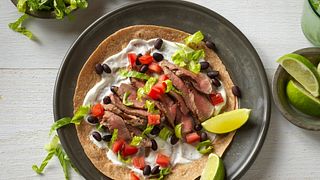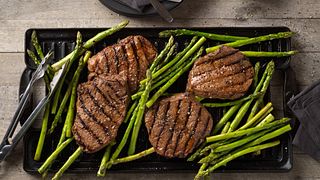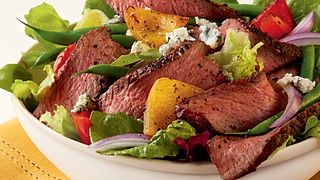Beef helps make every bite count for tweens and teens
Nutrition is important throughout life, and it’s essential to build a strong foundation of diet variety, nutrient density, and healthy habits during childhood and adolescence. This is because, during this stage of life, children are growing at a rapid pace, and a healthy, balanced dietary pattern provides the building blocks needed for growth and development. Yet, according to the Dietary Guidelines for Americans, school-age children and adolescents are falling short on consuming essential nutrients needed to build strong minds and strong bodies (1). Although tweens and teens are missing the mark on eating enough protein, iron, choline, vitamin B6 and B12, parents and caregivers have simple solutions at their fingertips! This stage of life is the perfect time to teach about healthy habits and the importance of nutrition for energy, focus, strength, and more.
Parents and caregivers can support growing kids with balanced diets rich in variety. This includes foods like fruits, vegetables, whole grains, and of course, sources of lean protein, like beef. In fact, beef provides many essential nutrients needed for childhood growth and development, including high-quality protein, iron, zinc, choline and B-vitamins (2).
The Dietary Guidelines for Americans (DGAs) recognize that lean meat, including beef, nourishes a healthy lifestyle (1). Protein, iron, zinc, choline, and B-vitamins in beef help ensure children build healthy bodies and brains (2-7).
Fueling Healthy Minds and Bodies
As infants and toddlers move beyond the early years and into childhood and adolescence, nutrition remains an important, impactful factor in growth and development. The tween and teen years are a time of transformational change and increasing independence, and adolescents’ nutrient needs set the stage for optimal health and reduced chronic disease risk during adulthood (1).
Did you know, on average, adolescents, 10- to 19-year-olds, gain 15-20 percent of their final adult height, and 40-50 percent of their adult weight during this time. Bone mass also increases by 40 percent (8, 9).
Poor nutrient intake during childhood and adolescence can lead to significant growth and learning challenges, such as delayed physical development, poor academic performance, and depressed immune function (1, 8, 9). To set children up for success, it’s important to make sure they eat a balanced diet that provides the nutrients needed to fuel play, empower learning, and optimize growth. Beef’s nutrient package uniquely contributes to healthy childhood growth and development – let's learn about how some of beef’s nutrients play a role:
Best School Lunch Ever Recipe Collection
It's back-to-school time! Use these simple, nutritious, tasty recipes to make sure your kids bring their favorites to school every day.
Kid-Friendly Recipe Collection
Tired of the same kids meals? Try something the whole family will love. Even the pickiest of eaters will love these kid-friendly recipes.
Beefy Breakfasts Recipe Collection
There’s something comforting and satisfying about a hot breakfast! Not to mention, eating a protein-rich breakfast keeps you feeling full, longer, which may result in less snacking throughout the day.
Nutrition for adolescent girls

While nutrient needs are important to prioritize throughout the lifespan, adolescent girls and women of child-bearing age have increased nutrient demands that merit special attention. However, adolescent girls, particularly in the 14–18-year-old age range, are under-consuming essential nutrients that promote good health now and also lay the foundation for good health into and throughout adulthood. During this life stage, inadequate nutrient intakes can have impactful consequences given that this is age range typically encompassing the onset of puberty, menarche and other hormonal changes including potential pregnancy (1).
Nutrients available in animal source foods, like beef provide key components that are critical to addressing increased requirements in this group like readily bioavailable heme iron, zinc and vitamin B12 (1, 10-13). Adolescent girls tend to consume less meat, poultry and eggs than adolescent boys, which can result in underconsumption of total protein and may exacerbate other nutrient shortfalls in choline, vitamin B12 and vitamin B6 -- nutrients available in beef (1).
k-12 School Food Service
As noted above, the 2020-2025 Dietary Guidelines for Americans has reported that the diet quality of school-age children and adolescents is poor (1). School meals can play an influential role in a child's development of a healthy eating pattern. For some, school meals can provide two thirds or more of their daily caloric intake.
As a nutrient-dense, high-quality lean protein, beef is a flavorful food which can be a foundational part of dietary patterns and healthful school meals. Providing high quality protein, zinc, iron, choline, phosphorus and B vitamins including B6 and B12, beef makes a perfect complement for other healthy foods on the plate like vegetables, fruits, whole grains and dairy -- which all provide their own unique mix of nutrients like vitamin C, folate, calcium, potassium and dietary fiber.
Tips for fueling tweens and teens with strong minds and bodies
Mealtimes fuel healthy routines, bolster focus during the school day, and can be valuable time to spend together as a family.
Help your child build a strong mind and body with these healthy eating tips:
- Did you know that families who eat dinners together tend to lead healthier lives (14)? Take a seat at the table , and encourage healthy meal patterns that include nutrient-dense foods like lean beef, fruits, vegetables, whole grains, and low-fat dairy!
- Cook meals together. Schedule time with your children to plan, purchase, prepare and cook meals together throughout the week. (15)
- Celebrate your family food traditions by teaching your children about favorite healthy foods and meals from your family’s culture and traditions. (15)
- Beef pairs perfectly with other nutrient-dense foods like vegetables, whole grains and fruits, which many children and teens should eat more often to meet daily recommendations. Burgers and sandwiches are a great opportunity to pair beef with delicious fruits and vegetables! Challenge your children to see how many colors of the rainbow can fit onto their beef burger!
Recipe ideas for healthy families:
- Are your children new to beef? Encourage acceptance of new foods by pairing them with favorite foods! Try out this Cheeseburger Mac, for example!
- Pair a Roast Beef Sandwich with your child’s favorite fruits and veggies for a for a protein rich satisfying snack after school.
- Add a colorful Beef Wrap to your child’s lunchbox to ensure they are fueling their bodies and brains with key nutrients.
- Grab some Beef Jerky Trail Mix for a quick, healthy snack on the go.
- Start your day strong by enjoying a boost of high-quality protein with Beef and Egg Bite Breakfast Mugs. It can be quick and easy to have a healthy, higher in protein breakfast -- skip the bars and go for a more budget friendly real food based breakfast instead.
- When school starts back up, life gets busy! This One Pot Lasagna Pasta is the perfect meal to save time (and dishes) in the evenings, and is even better the next day as an easy leftover lunch!
Videos And Continuing Education
Learn More
Subscribe to our newsletter so you don't miss the best recipes, cooking tips, and more.
Privacy Policy- U.S. Department of Agriculture and U.S. Department of Health and Human Services. Dietary Guidelines for Americans, 2020-2025. 9th Edition. Available at https://www.dietaryguidelines.gov/.
- U.S. Department of Agriculture, Agricultural Research Service, Nutrient Data Laboratory. FoodData Central. Available at fdc.nal.usda.gov (Beef composite, cooked - NDB Number: 13364).
- American Academy of Pediatrics Committee on Nutrition. Pediatric Nutrition, 8th Ed. Itasca, IL: American Academy of Pediatrics, 2019.
- Schwarzenberg SJ, Georgieff MK, Committee on Nutrition. Advocacy for improving nutrition in the first 1000 days to support childhood development and adult health. Pediatrics 2018;141(2).
- Gow ML, Ho M, Burrows TL, Baur LA, Stewart L, Hutchesson MJ, Cowell CT, Collins CE, Garnett SP. Impact of dietary macronutrient distribution on BMI and cardiometabolic outcomes in overweight and obese children and adolescents: a systematic review. Nutr Rev 2014;72(7):453-70.
- Hermoso M, Vucic V, Vollhardt C, Arsic A, Roman-Vinas B, Iglesia-Altaba I, Gurinovic M, Koletzko B. The effect of iron on cognitive development and function in infants, children and adolescents: a systematic review. Ann Nutr Metab 2011;59(2-4):154-65.
- Wallace TC, Blusztajn JK, Caudill MA, Klatt KC, Natker E, Zeisel SH, Zelman KM. Choline: The Underconsumed and Underappreciated Essential Nutrient. Nutr Today 2018;53(6):240-53.
- Lassi Z, Moin A, Bhutta Z. Nutrition in Middle Childhood and Adolescence. In: Bundy DAP, Silva Nd, Horton S, et al., editors. Child and Adolescent Health and Development. 3rd edition. Washington (DC): The International Bank for Reconstruction and Development / The World Bank; 2017 Nov 20. Chapter 11. Available from: https://www.ncbi.nlm.nih.gov/books/NBK525242/
- Norris SA, Frongillo EA, Black MM, Dong Y, Fall C, Lampl M, Liese AD, Naguib M, Prentice A, Rochat T, et al. Nutrition in adolescent growth and development. Lancet 2022;399(10320):172-84.
- Friedman AJ, Chen Z, Ford P, Johnson CA, Lopez AM, Shander A, Waters JH, van Wyck D. Iron deficiency anemia in women across the life span. J Womens Health (Larchmt) 2012;21(12):1282-9.
- Agarwal S, Fulgoni VL, 3rd. Contribution of beef to key nutrient intakes in American adults: an updated analysis with NHANES 2011-2018. Nutr Res 2022;105:105-12.
- Klurfeld DM. The whole food beef matrix is more than the sum of its parts. Crit Rev Food Sci Nutr 2022:1-9.
- Black MM. Micronutrient deficiencies and cognitive functioning. J Nutr 2003;133(11 Suppl 2):3927S-31S.
- Berge JM, Wall M, Hsueh TF, Fulkerson JA, Larson N, Neumark-Sztainer D. The protective role of family meals for youth obesity: 10-year longitudinal associations. J Pediatr 2015;166(2):296-301.
- Office of Disease Prevention and Health Promotion, Department of Health and Human Services. Help Your Child Build a Healthy Eating Routine. Available at https://www.dietaryguidelines.gov/sites/default/files/2021-12/DGA_KidsTeens_FactSheet-508c.pdf.







